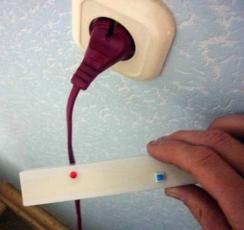Search
Login
Recommended
Hidden wiring, how to find damage in hidden wiring, useful tips
The presence of electricity in the house today seems to be taken for granted, we recall it only if some breakdowns suddenly occur and we lose the opportunity to use one of the most useful inventions of the past millennium. Nevertheless, during the construction of a house, or during its overhaul, it will be necessary to carefully consider all the nuances of wiring - in the end, only a rational choice of the type of cable laying can provide home owners with an uninterrupted supply of energy necessary for the operation of lighting devices and all modern household devices .
Content:
- Types of wiring, their advantages and disadvantages
- Hidden Wiring Requirements video
- Flush Detector video
- Other concealed wiring detection methods
- How to find hidden wiring in the wall using folk methods video
- Hidden wiring in the wall - how to find a wire break
- Experts recommend
Types of wiring, their advantages and disadvantages

It is difficult to clearly distinguish what type the electricity supply option used in the room belongs to, according to some - in the case of using hidden wiring, the route of the wires should not be noticeable at all, according to others - the option with a cable passing through pipes or cable channels should also be refer to the hidden type. In principle, the cable in this case is also invisible and is provided with protection against mechanical influences.
Traditionally, hidden wiring in the house involves laying all the wires in the walls, ceilings, floors, plates or baseboards. This option makes it safer.
For laying wires can be used:
- metal pipes
- flexible plastic corrugation or flexible metal hose,
- gates or building recesses, which are subsequently covered with plaster,
- space under a false ceiling,
- plastic wall panels.

Hidden wiring in the house has some drawbacks, the main ones are the difficulties that arise during installation work, including even the installation of a circuit breaker. Problems also arise when repairs or maintenance are required. Nevertheless, the hidden option has a number of advantages, which make it preferable to prefer the hidden wiring.
The name itself suggests that all wires should be hidden from view, i.e. the appearance of the room does not spoil the wires laid on the walls or ceilings, they do not create obstacles when performing repair and finishing work.
The wires are under a layer of plaster or concrete, which significantly limit the access of air, this contributes to a significant reduction in the level of fire hazard, in addition, this arrangement of wires minimizes the possibility of contact with live conductors. The service life of hidden wiring is much longer than open, due to the wiring being protected from exposure to sunlight and mechanical damage.

If we continue the discussion of the problems created by the hidden location of the wires, we should remember how problematic it may be to find the path laid by such an electrical wiring, with very high accuracy - otherwise, there may be a risk of damage to it when performing work related to gating walls or by drilling holes.
When performing the installation of hidden wiring, it is required to provide the location points of the outlets - subsequently their installation will be quite problematic. The cross-section of the wires used to lay the hidden wiring should be larger than if the wiring was laid externally.
Hidden Wiring Requirements
Among the basic requirements for hidden wiring is ensuring fire safety, it is especially necessary to be careful about wiring when it is carried out in a wooden house and laid under the inner sheathing; steel or PVC pipes should be used to lay the cable.

- You should also consider the possibility of replacing or adding wires, if necessary, but, unfortunately, in practice it is not always possible to fulfill this requirement.
- The wiring path should not be arbitrary, it is customary to lay cable crossings at a height of 2.5 m or under the ceiling, strictly horizontally or vertically, even if this leads to increased consumption of materials.
- When laying wiring, a plan must be drawn up, all junction boxes are indicated on it, it is mandatory to adhere to the plan when performing work, it is also desirable to ensure its safety for the entire period of operation of the constructed power supply system.
Experts recommend that when performing hidden wiring, a third conductor (PE) must be provided, even if there is no corresponding main wire on the shield at the time of connection, you can connect the wire left free when possible.
For rooms with a high level of danger (kitchen, bathroom), it is advisable to provide for the installation of differential circuit breakers or RCDs.
Flush Detector
Since the search for damage to hidden wiring can be problematic, you will need to use special signaling devices. These devices will help not only electricians, but also owners of private houses and even ordinary city apartments. The detector is completely safe in operation; when using it, direct contact of the device with sockets or bare wires, i.e. It is safer than a commonly used tester.

Using a hidden wiring detector, it is easy to determine the exact location of the cable and accurately identify the breakage point, if any. When passing the location of the cable, under voltage, the signaling device will give a visual signal - the LED light will turn on. For the device to operate, the effect of an electrostatic field formed by alternating current is sufficient. Those. direct contact of the device with the wire is not required. On some models of detectors, the function of giving an audio signal is possible.
A safe and easy-to-use, non-contact detector will undoubtedly turn out to be a necessary item in the household - it will allow the home foreman to find cables hidden in the walls or to find a place for an open circuit without outside help and without specialists, which will greatly simplify repair work and eliminate the need to remove plaster from the whole wall.
Other concealed wiring detection methods
Unfortunately, often homeowners do not have reliable information about the exact location of the cables for hidden wiring, in addition, no one can give guarantees that the wiring corresponds exactly to the plan, especially if the work was carried out several years, or even decades ago . Professional tools that we mentioned above also do not always appear at the right time at hand. It is likely that there will be a situation when it is required to find damage to the hidden wiring with the help of tools that will be at hand at the right time. Well, if you can find any testers, indicators, alarms, probes.

Of the modern tools that can be purchased at affordable prices, experts recommend paying attention to the following models.
- Signaling device E-121, in the people it is often called the Woodpecker. It is readily used by professional electricians, the device is highly sensitive and can detect a rush of wires located in the wall at a depth of about 7 cm.
- MS signaling devices are manufactured in China, in addition to wiring located in the wall, with their help you can easily detect any other metal objects located inside the walls (tester MS-58M). But at the same time, with the help of a tester, it will not be possible to find objects wrapped in foil - the foil serves as a screen that creates a barrier to metal detection.
Working with signaling devices will require some preparation - the signal given when the wires are detected will differ from that which is emitted when any metal object is detected.
POSP-1 devices are able to warn not only about the presence of wiring in the wall, but also give a signal about the presence of an alternating electric field emitted, for example, by an electrical panel.
Different models of devices of the VP-4404 brand are distinguished by the ability to accurately locate wire breaks, which serves as an occasion for increased interest in them by professional craftsmen and home craftsmen.
Masters recommend: regardless of the signaling device used, hidden wiring in the wall should be sought with utmost care and accuracy, in compliance with the rules and regulations for performing this kind of work.
How to find hidden wiring in the wall using folk methods
If modern signaling devices are not at hand, and buying them seems irrational due to the high cost, then you can apply the old methods that were used by masters in the past. One such option is to use a radio tuned to a frequency of 100 kHz. Turning on the receiver, it should be slowly moved along the wall; in places where the wiring is located, distinctive crackles and noises will appear in the dynamics.

If it is possible to remove wallpaper from the walls, then determine the location of the wires will help the roughness on concrete available in the places of their placement. If installation work was carried out according to the rules, then the wires should run horizontally or vertically.
Hidden wiring in the wall - how to find a wire break
The process begins by identifying a damaged wire, phase or zero. You can determine this by touching the screwdriver with the indicator to the contacts of the inoperative switch or outlet. In this case, when the switch is turned off, only one of the contacts should be energized, and both should be on. The working outlet has only one of the contacts energized. Having detected the presence of a phase on the above devices, it can be assumed that the neutral wire is disconnected.

In the event of damage to an inaccessible wiring section, it is best to contact a professional electrician for help, finding the place of damage yourself, without the use of special devices, will be difficult.
If access to all sections of the wiring is available, then it will be easy to find a problem place using any of the testers-alarms.
The order of the work will be as follows:
- First, the voltage is turned off on the shield.
- Then the insulation is cut and small serifs are made so that access to the metal conductor appears.
- The first notch is made at the point of exit of the wire from the junction box, the second at a distance of about two meters.
- Applying a tester measure the resistance in this area. Its small value indicates the absence of cliffs.
- A similar test should be performed in subsequent sections until the device shows that there is no resistance.
Experts recommend
If the place of the alleged cliff is placed in a brick or plastered wall, then it can be detected using a contactless indicator designed to detect hidden wiring.

Correct routing of wires - horizontally or vertically, with mandatory rotations strictly at an angle of 90 degrees, will greatly simplify the process of tracking the wiring path.





